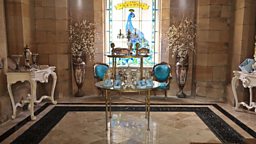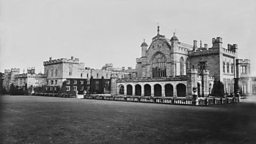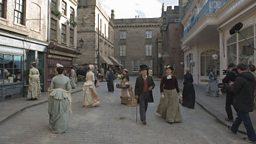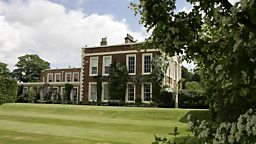6 Answers
The Paradise narrative is inspired by Emile Zola’s novel Au Bonheur des Dames which was set in Paris during the second half of the nineteenth century.
Our location, however, is the north east of England, and our story loosely based upon the first department stores to open there, rather than the Bon Marché on the Parisian Left Bank. In Zola’s Paris the new Grand Magasin attracted middle class and wealthy customers and the British stores enjoyed a similar client base. The north English aristocracy enriched with coal and industrial wealth enjoyed the buzz of the modern city as much as country pursuits and the Weston family reflect this world of the Victorian upper class.
The Paradise is filmed entirely on location at the Lambton Estate in County Durham, which comprises Lambton Castle and Biddick Hall, and which is the ancestral seat of the Lambton family (the Earls of Durham). The estate’s history of people, architecture and business is in many ways reflective of the entrepreneurial and intoxicating world of The Paradise. Below, the producer Simon Lewis talks about the challenges of filming at Lambton.
Filming at Lambton
Although the first department store in the country was in Newcastle, it’s a coincidence that we ended up filming in the North East and we looked at many other locations across the country before choosing the Lambton Estate.

At the time we only had a vague idea of what we wanted, which was something that had a grand interior, so our location manager did a lot of research into houses that might be suitable. When we first saw the castle on the Lambton Estate it had plaster falling off the walls, lots of leaks and it was very cold and wet - but it had lots of potential. It had a beautiful hall, gorgeous staircase and a lovely room downstairs that we use as the Ladieswear department. There are also plenty of interesting spaces in the back of the castle, including the long corridors upstairs which we turned into dormitories for the shop girls.
All in all the work took about six months, but it came in stages. We had to do drawings and submit them to the council and we had to obtain planning permission before we could start the work. It was a difficult task in the time and nobody thought that we were going to be ready to shoot the first series. On the first day of filming only one set had been completed, which was Lovett Drapery’s interior, but gradually within about a month of us starting everything was finished. Tollgate Street was the last thing to be finished because the rain was terrible.
When working on an historic building you can’t use modern materials; you’ve got to use the same materials the house was built in. So we had to use a lime-based plaster for the walls and whereas a modern-day plaster will dry in two or three days, a lime-based plaster isn’t dry after three weeks. The walls were still wet as we were filming on some sets and we had lots of big heaters off camera, blowing at the walls trying to dry them!
Our Art Department put an enormous and incredibly detailed amount of work into creating the internal spaces. We went to lots of local auctions and bought items in multiples as we needed lots to look like a well-stocked shop. If anyone was selling a collection of pipes, mugs, shaving brushes, anything - we bought them. We bought items on the internet from abroad - a lot of the tables and chairs in the Great Hall are from Indonesia, all the chandeliers are from Bulgaria. We sprayed everything gold so all the colours are light and bright. I wanted the interiors to sparkle with 19th century bling, before they knew what bling was.
Lambton Castle
Bill Lancaster, Historical Consultant for the series, looks further at this fascinating location and the wider world of Victorian industry and commerce in the north east of England.

Lambton Castle enjoys a pleasant location in the wooded, meandering section of the Wear Valley near Chester le Street in County Durham. It was built in the early nineteenth century by John George Lambton, first Earl of Durham and former Governor General of Canada, and designed by the famous Italian architect Joseph Bonomi the Elder and his son Ignatius in the then fashionable Norman style. The first Earl was known as ‘Radical Jack’, because of his prominent position in the Whig party and his closeness to Earl Gray, another north east landowner. Gray was leader of the Northern aristocratic Whigs, whose power reflected their growing wealth often based upon coal and he was also the Prime Minister who succeeded in the passing of the 1832 Reform Act.
The Lambton family can trace its local origins back to the 12th century and by the early 1800s had accumulated large landholdings in County Durham. With the rise of the coal industry during the 18th century and its rapid growth during the 19th, the north east landed aristocracy, thanks to their mineral rights, became extremely wealthy. What had for most of its history been one of England’s poorest regions became, thanks to King Coal, one of the most prosperous.
As their wealth grew, the Lambtons and their aristocratic neighbours embarked upon a building spree. The Duke of Northumberland restored Alnwick Castle; the Bowes Lyons, the late Queen Mother’s family, refurbished their stately homes in the region and laid out the Gibside estate in classic style including the Column of Liberty, which is taller than Nelson’s Column. Lord Londonderry, the Lambtons’ immediate neighbour, created a ‘palace at Wyndyard’ on the southern edge of the coalfield and the Newcastle engineering magnate, Sir William Armstrong, who also had coalmining interests, built Cragside in Northumberland, before moving on to rebuild Bamburgh Castle on the Northumbrian coast.
One of the most unusual buildings of this era is Penshaw Monument, a folly based upon the Temple of Hephaestus in Athens. The monument is dedicated to John Lambton, the first Earl. Built in 1844, four years after the earl’s death, it stands upon a hill given by Lord Londonderry. Much of the region’s architectural heritage originated during this period of mining prosperity.
The Lambtons were unfortunate in the location of their castle. Visitors marvelled at the vistas from the battlements, skilfully arranged by the planting of trees so that mines and miners were scarcely visible. But their attempt to recreate Arcadia on the Great Northern Coalfield was doomed by the very source of its creation. The Lambton mines which ran under the castle used the ‘board and pillar’ method and in order to increase output the pillars were often left too narrow to support the ground above. By the 1860s Bonomi’s castellated masterpiece was in danger of collapse due to subsidence as the ‘pillars’ below gave way.
The famous Newcastle architect John Dobson was recruited to repair and rebuild much of the structure. Dobson’s improvements almost doubled the size of the castle, but the work completed by Sydney Smirke, Dobson’s son in law, and his addition of a hall based upon Hampton Court Chapel, was unpopular with the family. Despite the mishmash of styles, Pevsner took delight in the ‘…picturesqueness of Lambton Castle’, but the twentieth century was not kind to the building. Subsidence continued to plague the castle which was partly demolished during the 1930’s. Mining continued to haunt the Lambton name: Radical Jack’s nearby great monument on Penshaw Hill had to be partly dismantled and rebuilt in 1979 due to subsidence.
Newcastle and Shopping during the Nineteenth Century
It often surprises visitors to discover that Newcastle is not an industrial city. The region’s mining and heavy industry was conducted outside of the city and Newcastle’s historic function as a regional commercial capital reached its peak during the nineteenth century. As coal exports rapidly increased, Newcastle became the centre of the world’s then most important commodity. The Tyne became one of Europe’s largest ports and was described as ‘The great cornucopia of all the Northern parts’. Wealthy visitors commented on the quality and range of goods in local shops which they had thought could only be obtained in London. John Dobson, who redesigned Lambton Castle, was employed by local developer, Richard Grainger to plan the rebuilding of Newcastle’s central area. This late Georgian masterpiece has been described as the world’s first modern city centre, completed decades before Haussmann did a similar, albeit much larger, treatment in Paris.

This precocious, modern urbanisation became the venue for the world’s first department store, Bainbridge’s, in 1837, which opened a few months before Kendal, Milne and Faulkner in Manchester. Coal in Newcastle and cotton in Manchester created a burgeoning lower middle class of clerks and managers who needed to establish a new lifestyle, which distinguished them from the working class. Their employment demanded that they shared their company owners’ manners, language and style. The new department store was quick to spot the aspirational nature of the emerging new social class and to ensure their patronage developed two strategies. The first was the novelty of marked prices, essential to customers on fixed salaries, and the second was to create an ethos of luxury in order to satisfy their clients’ ambitions. Bainbridge’s discovered another key ingredient in the triumph of the department store: variety.
By the 1870s Bainbridge’s boasted more than forty retail departments and employed an army of seamstresses, milliners and dress makers in the store’s upper floors. The mid-Victorian department store also created female space, a sanctuary in the bustling, male dominated city centre. Fashion models displayed garments prior to purchase and ‘making up’ in the ‘fitting rooms’ were supervised by senior female staff and many departments were managed by female buyers. Tea rooms, toilets and reading areas all served to create an ethos of womanly comfort and the department stores became the key social venue for middle and upper class women. Paradoxically, although founded by men, the perception of department stores as women’s territory resulted in male reluctance to enter these ‘cathedrals of consumption’ resulting in stores establishing ‘men’s shops’ with a separate entrance.
Bainbridge’s and its Newcastle rivals, especially Fenwick’s, enjoyed reputations for high fashion and quality. Created for middle class women, the proprietors soon found that the region’s upper class ladies preferred the frisson of conspicuous shopping in the new establishments, to the stuffy world of traditional drapers. By the late nineteenth century Newcastle stores advertised on the front page of the Daily Mail, Britain’s most expensive advertising medium, and the local press were reporting the shopping visits by the ‘Empress of Germany, three continental princesses, Mrs Alfred Harmsworth, Miss Vesta Tilley, Miss Ellen Terry, Miss Irene Vanbrugh, Mrs Barney Barnato, and of course, Miss Dorothea Baird.’
The Paradise brings great wealth and success to the Weston’s and John Moray and similarly the patronage of such esteemed customers brought great wealth to the Bainbridge and Fenwick families. Bainbridge’s invested heavily in coal mining companies, shipbuilders and steel works, where they became board members alongside the husbands and fathers of their wealthier customers. The family joined the northern aristocracy and industrial magnates in other ways, building grand houses in the Northumbrian countryside including the neo-classical Eshott Hall. Bainbridge enjoyed lengthy Norwegian fishing trips and also owned a Scottish hunting lodge - but never forgetting business he recruited the local grocery boy for the store’s Food Hall.

Biddick Hall, on the Lambton Estate (built in the 18th Century), is the location used for the Glendenning/Weston family house and is where the Lambton family moved once they vacated the uninhabitable Castle in 1932. Although the Castle was reconfigured into the present building with the intention that the family would move back in, they never did. The Newcastle stores became key institutions in Grainger and Dobson’s ‘City of Palaces’ and the retail revolution which they created, and which The Paradise embodies, has proved to be more enduring than the industrial one.
http://www.bbc.co.uk/programmes/profiles/5kB8TCm30QMWVcF3FkNrRvb/locating-paradise
| 9 years ago. Rating: 3 | |
Apart from the Paradise God speaks of,it has to be here..A place called Surfers Paradise, Queensland, Australia..>>>>>>>><<<<<<<<..
| 9 years ago. Rating: 3 | |

The dial itself, just like the other Aquaracer releases this year, link has a grooved pattern. Immediately, I'm reminded of the ceramic laser-engraved link wave pattern dials from Omega, but on this watch the effect is much more subdued. Dial text is link fairly balanced here, as well – only giving you what you need: The TAG Heuer branding, with the Aquaracer moniker beneath twelve o'clock, and the Automatic designation and depth rating above six o'clock.
| 22 days ago. Rating: 0 | |

 Rune P
Rune P
 ROMOS
ROMOS
 terryfossil 1
terryfossil 1
 esachiel2004
esachiel2004
 shirleywpankaj
shirleywpankaj




